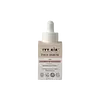What's inside
What's inside
 Key Ingredients
Key Ingredients

 Benefits
Benefits

 Concerns
Concerns

 Ingredients Side-by-side
Ingredients Side-by-side

Water
Skin ConditioningCoco-Caprylate/Caprate
EmollientC13-15 Alkane
SolventPropanediol
SolventGlycerin
HumectantCaprylic/Capric Triglyceride
MaskingSqualane
EmollientGlyceryl Stearate Citrate
EmollientPhenoxyethanol
PreservativeSclerotium Gum
Emulsion StabilisingLysolecithin
EmulsifyingRetinol
Skin ConditioningPhospholipids
Skin ConditioningCetyl Alcohol
EmollientSodium Hyaluronate
HumectantXanthan Gum
EmulsifyingPullulan
Glycine Soja Oil
EmollientSodium Phytate
Ethylhexylglycerin
Skin ConditioningTocopherol
AntioxidantSilica
AbrasiveBeta-Sitosterol
Emulsion StabilisingLactic Acid
BufferingSqualene
EmollientWater, Coco-Caprylate/Caprate, C13-15 Alkane, Propanediol, Glycerin, Caprylic/Capric Triglyceride, Squalane, Glyceryl Stearate Citrate, Phenoxyethanol, Sclerotium Gum, Lysolecithin, Retinol, Phospholipids, Cetyl Alcohol, Sodium Hyaluronate, Xanthan Gum, Pullulan, Glycine Soja Oil, Sodium Phytate, Ethylhexylglycerin, Tocopherol, Silica, Beta-Sitosterol, Lactic Acid, Squalene
Water
Skin ConditioningPropanediol
SolventPropylene Glycol
HumectantGlycerin
HumectantCorn Gluten Amino Acids
Skin ConditioningSodium Polyglutamate
HumectantHydroxypropyl Cyclodextrin
MaskingPEG-40 Hydrogenated Castor Oil
EmulsifyingSodium Hyaluronate
HumectantRetinol
Skin ConditioningOligopeptide-1
Skin ConditioningOligopeptide-2
Skin ConditioningOligopeptide-5
Skin ConditioningHyaluronic Acid
HumectantCollagen
MoisturisingAdenosine
Skin ConditioningAloe Barbadensis Leaf Extract
EmollientYeast Ferment Extract
Skin ConditioningSilk Extract
Skin ConditioningAvena Sativa Kernel Extract
AbrasiveMentha Arvensis Leaf Extract
MaskingPelargonium Graveolens Extract
MaskingPortulaca Oleracea Extract
Skin ConditioningChrysanthemum Indicum Flower Extract
Skin ConditioningSophora Flavescens Root Extract
AntioxidantBeta-Glucan
Skin ConditioningButylene Glycol
HumectantHexylene Glycol
EmulsifyingXanthan Gum
Emulsifying1,2-Hexanediol
Skin ConditioningSodium Benzoate
MaskingEthylhexylglycerin
Skin ConditioningPotassium Sorbate
PreservativeSodium Hydroxide
BufferingHydroxyacetophenone
AntioxidantPhenoxyethanol
PreservativeWater, Propanediol, Propylene Glycol, Glycerin, Corn Gluten Amino Acids, Sodium Polyglutamate, Hydroxypropyl Cyclodextrin, PEG-40 Hydrogenated Castor Oil, Sodium Hyaluronate, Retinol, Oligopeptide-1, Oligopeptide-2, Oligopeptide-5, Hyaluronic Acid, Collagen, Adenosine, Aloe Barbadensis Leaf Extract, Yeast Ferment Extract, Silk Extract, Avena Sativa Kernel Extract, Mentha Arvensis Leaf Extract, Pelargonium Graveolens Extract, Portulaca Oleracea Extract, Chrysanthemum Indicum Flower Extract, Sophora Flavescens Root Extract, Beta-Glucan, Butylene Glycol, Hexylene Glycol, Xanthan Gum, 1,2-Hexanediol, Sodium Benzoate, Ethylhexylglycerin, Potassium Sorbate, Sodium Hydroxide, Hydroxyacetophenone, Phenoxyethanol
 Reviews
Reviews

Ingredients Explained
These ingredients are found in both products.
Ingredients higher up in an ingredient list are typically present in a larger amount.
Ethylhexylglycerin (we can't pronounce this either) is commonly used as a preservative and skin softener. It is derived from glyceryl.
You might see Ethylhexylglycerin often paired with other preservatives such as phenoxyethanol. Ethylhexylglycerin has been found to increase the effectiveness of these other preservatives.
Glycerin is already naturally found in your skin. It helps moisturize and protect your skin.
A study from 2016 found glycerin to be more effective as a humectant than AHAs and hyaluronic acid.
As a humectant, it helps the skin stay hydrated by pulling moisture to your skin. The low molecular weight of glycerin allows it to pull moisture into the deeper layers of your skin.
Hydrated skin improves your skin barrier; Your skin barrier helps protect against irritants and bacteria.
Glycerin has also been found to have antimicrobial and antiviral properties. Due to these properties, glycerin is often used in wound and burn treatments.
In cosmetics, glycerin is usually derived from plants such as soybean or palm. However, it can also be sourced from animals, such as tallow or animal fat.
This ingredient is organic, colorless, odorless, and non-toxic.
Glycerin is the name for this ingredient in American English. British English uses Glycerol/Glycerine.
Learn more about GlycerinPhenoxyethanol is a preservative that has germicide, antimicrobial, and aromatic properties. Studies show that phenoxyethanol can prevent microbial growth. By itself, it has a scent that is similar to that of a rose.
It's often used in formulations along with Caprylyl Glycol to preserve the shelf life of products.
Propanediol is an all-star ingredient. It softens, hydrates, and smooths the skin.
It’s often used to:
Propanediol is not likely to cause sensitivity and considered safe to use. It is derived from corn or petroleum with a clear color and no scent.
Learn more about PropanediolRetinol is a gold-standard ingredient for anti-aging. It is a form of Vitamin A and belongs to the class of retinoids that also includes tretinoin.
Why is retinol famous?
It has the most scientific studies backing up its skin benefits out of all the non-prescription ingredients.
Retinol is proven to:
This is why retinol is effective at removing wrinkles, fading dark spots, treating acne, and reducing the appearance of pores.
Studies show retinol is less effective when exposed to UV. Be sure to look for appropriate packaging to keep your retinol potent (similar to Vitamin C).
Using retinol or any retinoids will increase sun-sensitivity in the first few months. Though studies show retinoids increase your skin's natural SPF with continuous use, it is best to always wear sunscreen and sun-protection.
We recommend speaking with a medical professional about using this ingredient during pregnancy.
Retinol may cause irritation in some people, so be sure to patch test. Experts recommend 'ramping up' retinol use: start using this ingredient once a week and work up to using it daily.
Read about Tretinoin
Learn more about RetinolSodium Hyaluronate is hyaluronic acid's salt form. It is commonly derived from the sodium salt of hyaluronic acid.
Like hyaluronic acid, it is great at holding water and acts as a humectant. This makes it a great skin hydrating ingredient.
Sodium Hyaluronate is naturally occurring in our bodies and is mostly found in eye fluid and joints.
These are some other common types of Hyaluronic Acid:
Learn more about Sodium HyaluronateWater. It's the most common cosmetic ingredient of all. You'll usually see it at the top of ingredient lists, meaning that it makes up the largest part of the product.
So why is it so popular? Water most often acts as a solvent - this means that it helps dissolve other ingredients into the formulation.
You'll also recognize water as that liquid we all need to stay alive. If you see this, drink a glass of water. Stay hydrated!
Learn more about WaterXanthan gum is used as a stabilizer and thickener within cosmetic products. It helps give products a sticky, thick feeling - preventing them from being too runny.
On the technical side of things, xanthan gum is a polysaccharide - a combination consisting of multiple sugar molecules bonded together.
Xanthan gum is a pretty common and great ingredient. It is a natural, non-toxic, non-irritating ingredient that is also commonly used in food products.
Learn more about Xanthan Gum